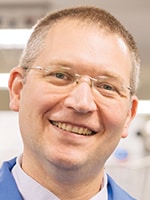In a roundtable, platform change pointers
Valerie Neff Newitt
June 2023—Transporting specimens to the laboratory, and processing and distributing them within the lab, will be what AACC meeting-goers hear about in a session next month.
In another session, making inefficient workflows more efficient with technology that’s available now will be one speaker’s focus. And in one of the many roundtables, a leader will talk about how to ensure a successful go-live for a new clinical chemistry analyzer.
Just some of what awaits in the way of advances in lab transport and efficiencies for core and other laboratories.
“I don’t think we hold the same standards of monitoring temperatures for our specimens that we do for our reagents,” says Joe Wiencek, PhD, D(ABCC), a scheduled speaker and service line medical director of the Vanderbilt University Medical Center core laboratory and medical director of clinical chemistry. He describes himself as “almost the town crier” on the importance of proper external specimen transport to the lab. “We really do need to address it,” he says.

Dr. Wiencek
He and others are doing that now in the form of the first Clinical and Laboratory Standards Institute document on the evaluation of external specimen transport processes. It’s in the final development phase, says Dr. Wiencek, the group’s chair. “We’ve been meeting for about a year and a half with a globally diverse group of individuals who are dedicated to getting a document together on all the useful information that’s been published for the benefit of all clinical labs as well as clinical areas of medicine.”
He organized the AACC session on advances in transport to highlight prospective ways to standardize the approach to specimen handling and transport, “regardless of your climate zone,” he says. “Patient specimens must be kept in appropriate temperatures throughout the transport process.”
The summertime heat in Nashville sparked his interest in external transport. “I started to notice that some of the courier boxes bake in the sun, so we started to study this. And it’s become even more important recently because of the heat waves that are impacting all regions in the United States and other areas of the world.”
When Dr. Wiencek thinks of external specimen transport, he thinks, too, of 2019 and the polar vortex. “That resulted in extreme cold in the North and Midwest. And that same year there was a heat wave in Phoenix, Arizona, where the paint was melting off the street signs and several cargo and transport planes were grounded. We should be thinking about the effects of extreme heat and cold on our patient specimens.”
The CLSI document that is in the works, and his session next month, are about “making sure we have the proper guidance and support for the transport of those specimens from point A to point B,” he says.
Dr. Wiencek was a coauthor of a paper published in the American Journal of Clinical Pathology on the guidance provided by a group of academic, private, and reference labs to their clients on how to store and ship specimens (Dibbern ME, et al. Am J Clin Pathol. 2021;156[5]:866–870). “The only thing that was consistent among all those groups were the inconsistencies associated with their transport processes,” he says, such as how many cold packs to use and where to place the storage box. His discussions with people in the clinics who use the boxes reveal that a box’s placement “is up to them,” he says. “They could put the courier box wherever they feel like putting it,” including on the side of the building where there’s sunlight for extended hours.
Dr. Wiencek selected his co-speakers for the transport session, one of whom is Timothy Amukele, MD, PhD, of Icon Clinical Research, who will talk about the use of drones. “Dr. Amukele was one of the first individuals in the world to start to look at drones as a way to transport specimens, and that has kind of grown. It’s important to think about not only for rural settings but also urban settings,” where traffic is heavy and where the specimens have to be transported to an offsite clinical laboratory or core lab, he says.

Dr. Genzen
Jonathan Genzen, MD, PhD, chief medical officer at ARUP Laboratories and the third speaker, will take attendees inside the lab with a look at efficiency in specimen processing and distribution through automation.
“There are certainly opportunities for efficiency and improvement in many areas around the lab,” including specimen handling and integrity checks for hemolysis, icterus, and lipemia, where automation can help, says Dr. Genzen, who chairs the CAP Clinical Chemistry Committee. At ARUP, he and others are investigating the use of autonomous intelligent vehicles. “Basically mobile robots that can help distribute specimens across laboratory areas,” he says. “In our case it’s across buildings and even a bridge.” He’ll share examples and photos of what they’re testing at ARUP.
The technology itself isn’t new, he notes, but the improved quality of the robotics and the ability to use wireless networks to tell the robotics where they need to go is noteworthy. “The robots can detect whether there is anything blocking their path—a person, a cart, or something else. The sensors on these robotics are much better than they were in the past.” He says he and his colleagues have found the technology to be particularly useful in specimen distribution. “We use autonomous intelligent vehicles, for example, to bring specimens to our automated storage unit after testing is complete.”
 CAP TODAY Pathology/Laboratory Medicine/Laboratory Management
CAP TODAY Pathology/Laboratory Medicine/Laboratory Management
